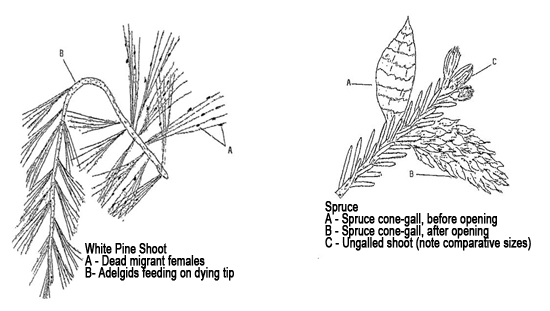DACF Home → Bureaus & Programs → Maine Forest Service → Forest Health & Monitoring → Forest Pest Index → Pine Leaf Adelgid
PINE LEAF ADELGID
Pineus pinifoliae (Fitch)

Damage and Symptoms
Severe outbreaks can kill up to 100% of the new shoots on eastern white pine trees of all sizes and ages. Recurrences of heavy feeding in 2- 3 successive years can cause mortality especially among understory or less vigorous trees.
The pine leaf adelgid has a complicated two-year life cycle involving alternate hosts, white pine and red or black spruce. Damage to spruce is limited to the production of cone-like galls on new shoots that are of minor concern except on ornamentals where they may affect aesthetics. Heavy adelgid infestations on current-season white pine shoots can be severe and cause shoot tips to droop, turn yellow and die during the same season. Normally, however, damage becomes more obvious the following spring when the injured pine shoots turn brown and die.
The presence of migrant females in a row on needles of white pine, with all heads facing towards the base of the needle, is typical of this species and serves as a diagnostic character. These females, which are winged, black, and about 2.5 mm long, settle on the needles in June, then die and remain attached well into winter.
The adelgid form on pine shoots is so tiny that groups appear to the naked eye as "pepper-spots" on the light green twigs. They are actually oval, keeled, dark purplish-brown with fringes of wax plates around the body and along the keel. Insertion of stylets, feeding, and possibly salivary injections of numerous adelgids, causes a stunting, yellowing, and browning of the pine needles; and finally drooping and dying of the twigs. These symptoms show during the summer of the migration to pine, more so by fall and the next spring. The 2-year cycle results in browning of heavily infested white pine every other year.
Hosts
Red and black spruce are the primary hosts. Eastern white pine is the alternate host.
Life Cycle
The life cycle is complex, involves five different forms of the adelgid, and takes two years to complete. Infestations involving two forms on spruce cause cone-like galls in May as the new shoots develop. Migratory forms or migrant females emerge from the galls in mid-June and fly to white pine where they settle on the previous year’s needles, lay eggs and die in place. Eggs hatch and two separate forms of offspring crawl onto the developing pine shoots in early July, insert their stylets, and feed. The adelgids overwinter on pine and continue to feed in the spring before returning to spruce during the second season. Every other year, some aphids remain on pine but most migrate back to spruce to overwinter and to form galls the following spring to start a new cycle.
Control*
The least toxic method of controlling adelgids on ornamental white pine is with horticultural oil. Conventional insecticides that can be used, but are not limited to, include Merit (imidacloprid), Talstar (bifenthrin), Onyx (also a bifenthrin product), Astro (permethrin) and DeltaGuard (deltamethrin). Control is not normally recommended on spruce.
*NOTE: These recommendations are not a substitute for pesticide labeling. Read the label before applying any pesticide. Pesticide recommendations are contingent on continued EPA and Maine Board of Pesticides Control registration and are subject to change.
Caution
For your own protection and that of the environment, apply the insecticide only in strict accordance with specific use instructions and precautions.
MAINE DEPARTMENT OF AGRICULTURE, CONSERVATION AND FORESTRY
Maine Forest Service - Forest Health and Monitoring Division
July 2016